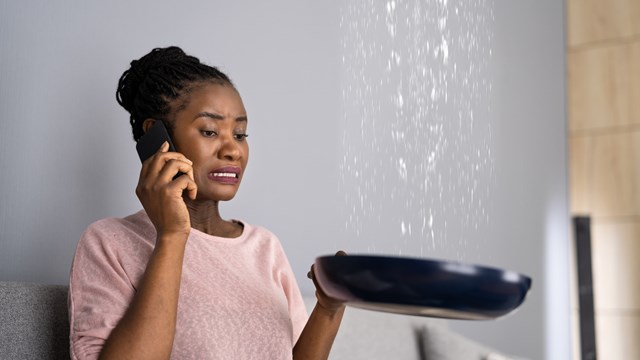Residential buildings are constantly under attack—not by barbarians or marauding bandits, but by a force far more subtle and insidious. The most tenacious enemy of a residential building is not fire or structural collapse—though a building obviously should be protected from such catastrophes. It’s water. Left unchecked, simple moisture can quietly infiltrate your building envelope and wreak havoc throughout.
Water damage usually doesn’t have the same dramatic and immediate impact that a fire has on a building, but the damage caused by water infiltration can be problematic for years, even long after the initial leak has been resolved. Mildew and mold are common problems associated with water infiltration in a building, and are not only gross to look at and tough to eradicate but may also pose health threats to residents. Over time, water seepage can also erode a building’s components, compromising their structure and necessitating expensive repairs, according to Henry Cercone, president of Cercone Exterior Restoration in Manhattan and the Bronx.
Because of these potentially devastating effects, co-op and condo boards, managers and staff members should have a general understanding of the makeup, maintenance and repair of their building’s waterproofing systems. While a building’s superintendent or property manager should be the first line of defense against leaks, broken pipes and so forth, board members and residents do play a role in protecting their building from the ravages of water. Watchful eyes now can save many thousands, or even millions of dollars, in repair costs later.
Keeping Dry
Every residential building has mechanisms that prevent water from seeping into the
structure but even when these systems are in top condition, they don’t make the building truly waterproof. Rather, they help to make the building resistant to water infiltration. The degree to which the systems keep the building dry depends upon how well they were installed, and how they are maintained.
“If you want to begin to waterproof the outside of a building and do it properly, No. 1, you have to have a specifier who understands what it takes to waterproof a wall,” says Jerry Yates, president of Yates Restoration in the Bronx. “No. 2, you need the correct materials and No. 3, you need the proper applicator. And if you do all of those things you can have a building that will stay water resistant for a good number of years, but nothing is permanent. Even with the best materials, specifications and contractor, eventually, even the best built structures can leak. You can in the short term, if things are done properly, keep water out of the building. Or at least if it gets into the building, control its flow so it doesn't interfere with the building's occupants.”
The roof of a building is the most important linchpin of a building’s waterproofing system, according to Cercone. “The integrity of the building performing in such a way that the building is tight and water-free will start at rooftop conditions such as sealed roofing membrane, sealed penetrations and coping covers,” he says. The drainage system for the roof—be it the downspouts on small buildings or the larger, internal roof drainage pipe known as a “leader” that is found in larger buildings—is also vital in keeping a building dry. Because the leader and downspouts take water off of a roof when it rains or snows, even a small blockage of that drainage system can back things up and quickly cause water damage to the building.
Most roofs in the city of the flat roof variety—are made up of several different types of material layered together—like the different levels of a person's skin. Those materials usually include a substructure of steel under a concrete deck, topped with a "vapor barrier" like tarred paper. Over that goes a layer of insulation several inches thick, which is in turn topped by a waterproof membrane—and a decorative decking material, in some cases.
The waterproof membrane functions much like the skin's epidermis, serving as the first—though by no means impenetrable—line of defense against the outside environment. Unlike our skin, however, roofs can only be expected to last between 10 and 25 years. Residents of buildings with rooftop gardens should be especially thorough with rooftop maintenance to avoid water infiltration. Andrew Wist, president of Standard Waterproofing Co. in the Bronx, emphasizes the importance of cleaning roof drains at least twice a year.
“We do a lot of rooftop gardens,” Wist says. “We come in the spring and check the entire roof for them, especially with the green roofs because there's a lot of dirt and debris. We have to make sure the drains are flowing because if a drain gets stuffed up it's basically a disaster. It becomes a flood in the building.”
Flashing on the roof, caulking around windows and doors, and mortar joints in a brick or stone facade also are integral parts of a building’s weather defense system. Keeping an eye on these various components to ensure they are properly functioning is critical.
While it may seem tough to keep a building free of unwanted rainwater or melting snow, the task is not so onerous if people keep on top of it. Part of that regular care should be routine check-ups. His company’s workers inspect client buildings twice a year, in the spring and the fall, says Wist, and customers are given a report on the condition of the building after each inspection. “If you take care of the building, you don’t have problems,” Wist says.
Don’t Get Soaked
Water making its way into a building leaves telltale signs for those who are able to spot them. Aside from obvious water stains on walls and ceiling leaks, Yates advises residents to watch for bubbling and streaking of wall paint. Signs of water infiltration might also be evident from outside of the building. “From the exterior, signs of water can be discoloration of the building materials, presence of moss or vegetation, peeling paint and cracked finishes and ceiling joints,” Cercone says. Also be on the lookout for rust, which can quickly destroy property or create damage that will cost a lot to repair. Rust stains can bleed through concrete or other masonry building exteriors, showing that metal inside or attached to the masonry is rusting and, hence, weaker and less structurally sound than it should be.
In addition to creating the need for repairs, water leaking into a building can make the structure an uncomfortable place in which to live. No resident wants to have to leave a cooking pot out to catch water dripping through a ceiling, or deal with incessantly recurring mold. Such conditions can make residents consider filing lawsuits against the board or others involved in managing the building. And increased maintenance fees resulting from poor maintenance of a building and subsequent necessary repairs also might lead some residents to sue.
Water leaking into a building can not only divide residents, it also can literally divide the building itself. Leaks, if left unrepaired long enough, can weaken a building’s structure. “If water has been infiltrating a building for a long period of time and people aren't aware of it, you might start to see the walls start to buckle,” Yates says. “When rust forms on steel it expands. In some cases where it's been a prolonged period of time and nobody has done any maintenance, you might have to replace the whole entire structural membrane. That's where rust is really a problem. Rust inside a building is insidious—it's not obvious—and when it becomes obvious you have a problem.”
Repairing such damage can be so costly that it might take years to do the work, and many years more to pay for it. The water problem often starts with a small leak or fissure, and gets worse from there.
Local Law 11 requires residential structures greater than six stories in height to undergo a total exterior facade building inspection every five years. An engineer and contractor will be hired to inspect the outer surface, and the engineer will write and submit to the board of directors a report on the building’s physical condition. If repairs are needed, the board might direct the engineer to write specifications for the work. Then the work will be put out to bid, and the board will review bids and pick a contractor for the job. If the roof of a flat-roofed building needs to be replaced, a contractor will likely use a liquid membrane that is rolled out and cures over time to create a watertight seal.
Costs & Disruptions
The cost of a major waterproofing project varies, depending upon the size of the building and the amount of work that needs to be done. The price of a major waterproofing project for a mid-sized building in Manhattan could start anywhere between $100,000 and $300,000, but the cost could range up to $2 million, Wist says.
How much time such a large project will take to complete depends not only upon the size and complexity of the job, says Wist, but also on the abilities of the contractor. “We just finished a job that was an eight-month project on a 40-story residential building. That was about $900,000. We used 24 men every day,” he says, but other jobs might take more or less time, depending on various factors.
Because so many residential buildings—especially older ones—have masonry walls, some waterproofing work can be quite disruptive to residents’ daily lives. Wall waterproofing jobs, or work on parapets, can be annoying. “Wall repair work is more complicated because there's engineering and steel work involved with the brickwork. You have to open up the facade, hang scaffolds, put a sidewalk bridge in front of the building,” Wist says.
Experts say above all, the most important aspect of any waterproofing job is hiring a contractor who has the proper qualifications and resources to complete the work correctly and efficiently. “Investigate the contractor—go look at his shop to see if he's a real contractor and not just a middleman,” Wist advises. “The real important thing in this day and age is insurance. A lot of contractors don't have the right insurance because insurance is very, very costly. These guys have defective insurance. Get references from the contractor. Use a contractor who owns his own equipment—not a general contractor—you want a waterproofing contractor.”
Jonathan Barnes is a freelance writer and a frequent contributor to The Cooperator and other publications. Editorial Assistant Enjolie Esteve contributed to this article.










Leave a Comment